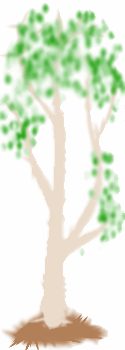
River Birch information & Care log
On a little table a lovely thick plant book lies open to the page on River Birch care ...
Kingdom: Plantae
Division: Magnoliophyta
Class: Magnoliopsida
Order: Fagales
Family: Betulaceae
Genus: Betula
Subgenus: Neurobetula
Species: B. nigra
River Birch (Betula nigra) is a common small birch native in flood plains or swamps in the eastern United States from New Hampshire west to southern Minnesota, and south to northern Florida and east Texas.
It is a small deciduous tree growing to about 25 m tall at most. The bark is very variable, usually dark gray-brown to pinkish-brown and thickly scaly, but in some individuals, smooth and creamy pinkish-white, exfoliating in curly papery sheets. The leaves are alternate, ovate, 5-12 cm long and 4-9 cm broad, with a serrated margin. The flowers are wind-pollinated catkins 3-6 cm long, the male catkins pendulous, the female catkins erect. The fruit is unusual among birches in maturing in late spring; it is composed of numerous tiny winged seeds packed between the catkin bracts.
While its native habitat is wet ground, it will grow on higher land, and its bark is quite distinctive, making it a favored ornamental tree for landscape use. A number of cultivars with much whiter bark than the normal wild type have been selected for garden planting, including 'Heritage' and 'Dura-heat'; these are notable as the only white-barked birches resistant to the bronze birch borer Agrilus anxius in warm areas of the southeastern US.
Native Americans used the boiled sap as a sweetener similar to maple syrup, and the inner bark as a survival food. It is usually too contorted and knotty to be of value as a timber tree.
The river birch occurs along stream beds from Massachusetts to Florida, zones 4 through 9A. It prefers moisture, but will tolerate dry soils.
Birches are much loved for bonsai because of their elegant beauty, but they do not take easily to pot culture. Their short lives are also seen as a disadvantage; however, some birches will live as long as 300 years
Lighting: Unlike most birches, the river birch prefers partial shade, and may suffer leaf burn if kept in full summer sun.
Temperature: River birch thrives in zones 5-8. It may need protection from cold winds to prevent twig die-back.
Watering: The river birch thrives in wet areas, and appreciates lots of water.
Feeding: Wait one month after leaves open, then feed every two weeks till the end of summer.
Pruning and wiring: River birch leaves will reduce significantly, to 1 1/4 inches, perhaps even smaller. Unlike many birch species, river birch does not seem to share the common problem of excessive "bleeding" after pruning, which makes this species easier to work with as a bonsai. Pruning upward branches at the second internode will encourage foliage to extend away from the trunk, opening the branch structure and keeping foliage from massing on branches parallel to the trunk.
Pests and diseases: Pests: No pests are of major concern. Resistant to bronze birch borer.
Diseases: Leaf spots; chlorosis on soils with a high pH.'
Next to the book there lies a pad of light green paper, which is often covered in scribbles of the care that has bene performed on the Birch, as it's resident sprite. You can make out ...
... It seems that you can't quite manage to read any of the scribbles just yet.





